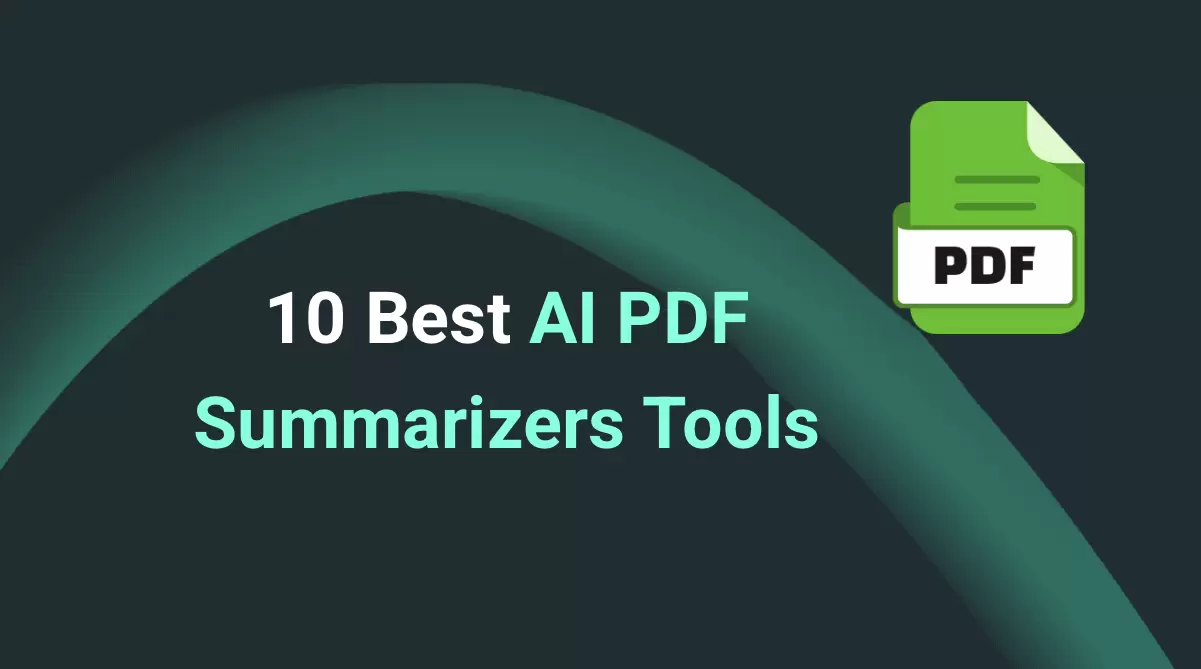Every business today runs on information, but finding that information often feels harder than it should. Employees jump from emails to shared drives, from CRMs to project tools, wasting hours just to locate a single document or answer. This constant switching between systems is not just frustrating; it creates delays, increases costs, and slows down decision-making. In fact, research shows that employees spend nearly a full working day each week simply searching for internal data. This is a clear sign that the problem isn’t the data itself, but how organizations access it.
This is where AI driven enterprise search comes in. Unlike traditional search tools that rely on keyword matching and often return long lists of irrelevant results, AI powered enterprise search uses artificial intelligence technologies like natural language processing (NLP) and machine learning (ML) to actually understand context. Instead of forcing employees to dig through multiple platforms, it connects all scattered data sources; structured databases, cloud apps, emails, and unstructured documents into one smart system. The result is not just locating a file, but delivering the exact, meaningful information an employee needs in real time.
The shift to AI driven enterprise search is more than just a technology upgrade; it is becoming a necessity for modern organizations. As businesses continue to generate vast amounts of data stored in thousands of different places, having a system that can unify and make sense of it all is critical. In the next sections, we’ll explore how this technology works, why it matters, and how it can turn fragmented information into a true competitive advantage.
Why Traditional Enterprise Search Fails
Traditional enterprise search tools were built for a very different digital environment than the one businesses face today. Back then, organizations had fewer systems, smaller data volumes, and simpler ways of storing information. Fast-forward to the modern enterprise, and the reality is completely different; businesses run on a complex mix of cloud platforms, collaboration tools, customer management systems, and unstructured communication channels. In this environment, traditional search approaches simply cannot keep up.

Below are the main reasons why they fail, and why organizations are now turning toward AI-Driven Enterprise Search as the smarter alternative.
1. Information Overload without Context
Modern enterprises generate enormous volumes of data every single day. Reports, transactions, product documentation, emails, chats, meeting notes, and even video files all form part of the organizational knowledge base. Traditional enterprise search engines rely heavily on keyword-based searches. They scan documents for exact matches but fail to understand context or meaning.
This leads to two major problems:
- Too many irrelevant results: Employees are presented with long lists of documents, most of which are unrelated to what they actually need.
- Missed information: If an employee doesn’t use the “right” keyword, the search engine may overlook important files altogether.
In today’s fast-paced business environment, this inefficiency means critical insights are buried, decisions are delayed, and productivity is lost. Enterprise AI search, by contrast, understands intent and context, turning this overload into meaningful knowledge retrieval.
2. Data Fragmentation and Siloed Systems
Another major limitation of traditional tools is their inability to connect data spread across multiple platforms. An average mid-sized business uses dozens of applications—CRMs like Salesforce, ERPs like SAP, project management tools, cloud storage systems, and collaboration platforms such as Slack or Microsoft Teams.
Traditional enterprise search lacks the interoperability to pull information from all these places into one unified search experience. Instead, employees must search each platform separately, wasting hours switching between systems and often missing critical data that is locked away in silos.
This fragmentation doesn’t just cause inconvenience; it has a measurable cost. Studies have shown that poor knowledge sharing can reduce overall organizational productivity by up to 25%. This is why many companies evaluating the best AI tools for enterprise search now prioritize solutions that can seamlessly integrate across all their data sources.
3. Outdated User Experience
Traditional search tools also struggle with usability. Many require employees to use rigid query formats or precise keywords to get meaningful results. For non-technical users, this is a frustrating experience that discourages adoption.
Key issues include:
- Complex search syntax that only trained users can manage.
- Poor ranking of results, where outdated or irrelevant documents appear at the top.
- No personalization, meaning the same search may return irrelevant results for different roles or departments.
Instead of acting as a productivity booster, traditional search often becomes a barrier. Employees spend time adjusting queries or manually filtering through results, which defeats the purpose of having a search tool in the first place.
4. Lack of Real-Time Insights
Traditional enterprise search engines were designed to index and retrieve static documents. But modern businesses need more than static files; they need live insights from constantly changing data. Whether it’s a customer’s latest support ticket, a supply chain update, or a sales forecast, real-time access to information is critical.
Since older systems cannot process or prioritize fresh data, they often provide outdated results. This delay creates risks: projects can be misaligned, customers can receive incorrect responses, and managers may base decisions on old information. AI-Driven Enterprise Search, on the other hand, continuously updates and adapts, ensuring employees always have access to the latest knowledge.
5. No Contextual or Semantic Understanding
Perhaps the biggest drawback is that traditional tools lack true understanding. They look for words, not meaning. For example, if an employee searches for “quarterly revenue,” the system may return every document containing the word “quarterly” or “revenue” separately, even if they are unrelated to financial performance.
This lack of semantic understanding makes it nearly impossible to get precise answers. In contrast, AI powered enterprise search can interpret natural language queries and deliver direct answers instead of forcing employees to sift through irrelevant documents.
6. The Hidden Cost of Inefficiency
All these issues; information overload, siloed data, poor usability, outdated results, and lack of context, translate into measurable financial losses. According to McKinsey, employees spend nearly 9 hours each week searching for internal information. An IDC study found that a business with just 1,000 knowledge workers could waste over $5 million annually due to poor search tools.
Beyond the financial cost, these inefficiencies affect morale and competitiveness. Teams feel frustrated; collaboration weakens, and companies risk falling behind more agile competitors who use smarter search systems.
The failures of traditional enterprise search make it clear that businesses need a new approach. Employees don’t just need to “find” documents; they need to access knowledge in context, across all systems, in real time. This is exactly what AI-Driven Enterprise Search delivers. By leveraging technologies like NLP and machine learning, it transforms disconnected data into actionable insights. In the next section, we’ll explore how AI-powered search works and why it’s rapidly becoming one of the best AI tools for enterprise search in today’s digital-first workplace.
How AI-Driven Enterprise Search Works: 5 Industry-Specific Use Cases
The best way to understand how AI driven enterprise search works is to look at real-world applications. Across industries, the challenge is the same: employees spend too much time searching for information hidden in scattered systems, databases, and documents. What changes from sector to sector is the type of data involved and the impact of delays. By examining specific use cases, it becomes clear how AI powered enterprise search not only saves time but also improves accuracy, compliance, and customer experience.
Use Case 1: Healthcare
Healthcare providers handle massive amounts of sensitive patient information, from electronic health records (EHRs) and lab reports to prescription histories and clinical guidelines. For doctors, one of the biggest pain points is the time wasted trying to locate relevant details across multiple systems. A physician might need to check a patient’s past medical history, verify possible drug interactions, or compare lab results with previous reports; all while ensuring that no critical detail is missed.
Traditional search systems within EHRs often make this harder instead of easier. They rely on rigid fields and keywords, meaning that unless a doctor knows the exact term or file location; the system may return incomplete or irrelevant results. This inefficiency doesn’t just slow doctors down; it increases the risk of medical errors, reduces time available for patient care, and creates frustration for both patients and providers.
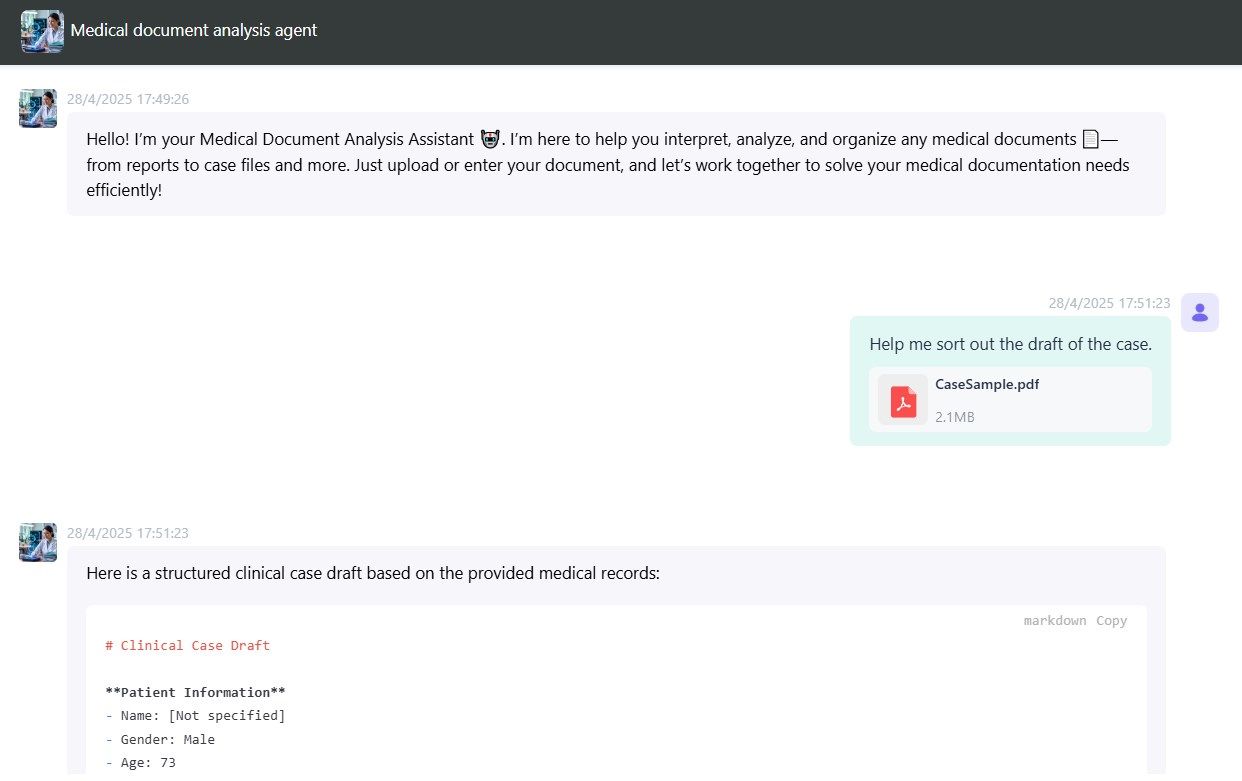
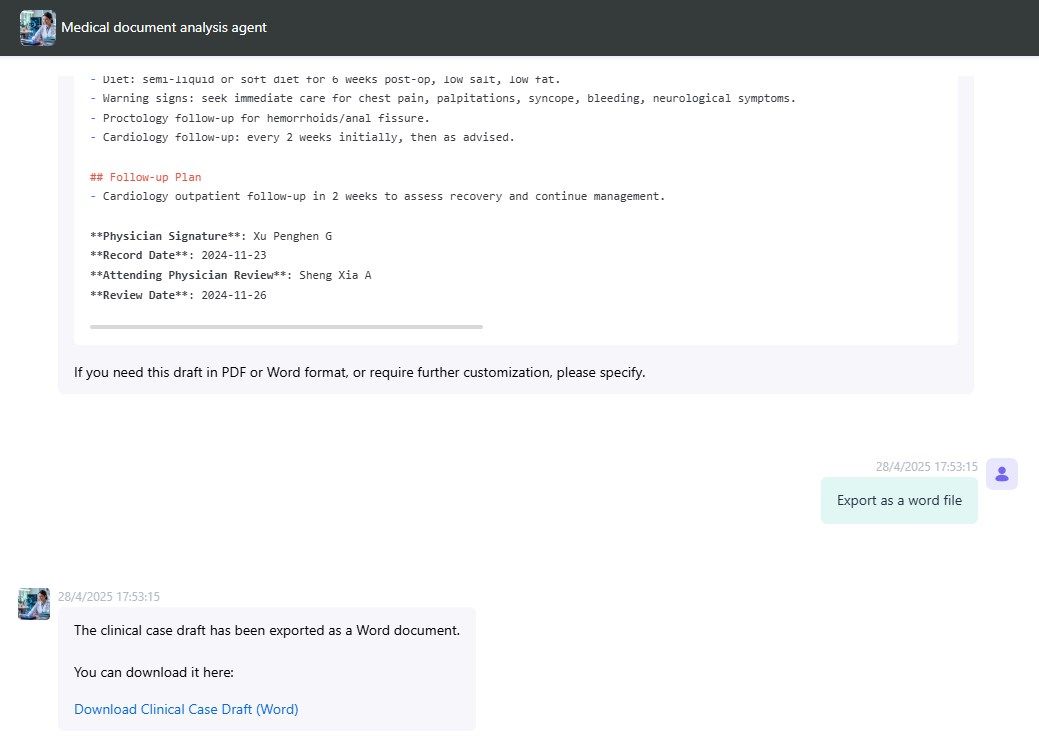
The AI Solution
This is where AI driven enterprise search steps in. Instead of relying on exact keywords, modern systems use natural language processing (NLP) and machine learning (ML) to understand the intent behind a query. A doctor can type or even speak a simple query such as “Show me this patient’s history of allergic reactions and current medications”, and the AI instantly retrieves the relevant information across all connected data sources; EHRs, lab systems, pharmacy records, and even unstructured documents like physician notes.
Solutions like GPTBots make this process even more powerful by allowing healthcare providers to build a systematic knowledge base. This knowledge base integrates both structured data (tables, reports, prescriptions) and unstructured data (scanned documents, clinical notes, treatment guidelines), creating a single source of truth. With features like semantic search, advanced document parsing, and precise data extraction, doctors don’t just “find files;” they get direct answers with references, ensuring maximum accuracy.

The Benefits
The benefits of applying enterprise AI search in healthcare are significant:
- Time savings for doctors: Instant retrieval of complete patient histories and drug interaction details reduces the time doctors spend on administration.
- Improved patient safety: AI highlights relevant drug interactions or missing details that might be overlooked in manual searches.
- Better decision-making: With quick access to structured and unstructured data, doctors can make more informed clinical decisions.
- Higher patient satisfaction: Faster, more accurate responses reduce waiting times and improve trust in care providers.
- Operational efficiency: Hospitals and clinics save resources by reducing duplicated tests, missed records, and repeated queries.
Real-World Example: GPTBots in Action
A leading healthcare provider recently implemented GPTBots’ AI Agent to address these exact challenges. By integrating medical records, treatment protocols, and patient data into a unified knowledge base, they transformed how doctors and staff accessed information.
The results were remarkable:
- The AI Agent began handling complex patient queries within weeks.
- Doctors received authoritative and precise answers instantly, cutting their average search time by 50%.
- Patient follow-up questions decreased by 35%, since initial answers were more complete and reliable.
- Overall patient satisfaction improved significantly, as care became more efficient and personalized.

This example highlights how AI powered enterprise search goes beyond just searching; it becomes a decision-support tool that directly impacts patient outcomes. With solutions like GPTBots, healthcare providers can ensure that vital knowledge is always at their fingertips, turning data complexity into actionable insights.
Use Case 2: Financial Services
The financial services industry operates under some of the most complex and fast-changing regulations in the world. Banks, insurance providers, investment firms, and fintech companies must constantly monitor new laws, regulatory frameworks, and policy updates issued by government bodies and financial authorities. Compliance teams are tasked with ensuring the organization follows every rule, from anti-money laundering (AML) standards to data privacy requirements.
The problem is that these regulations are massive and constantly evolving. A single compliance officer may need to track thousands of documents spanning different jurisdictions, often written in complex legal language. Manually reviewing each update is not only time-consuming but also prone to human error. Missing even one critical update can result in heavy fines, legal consequences, and reputational damage. Traditional search tools offer little help because they can only locate documents but cannot interpret which sections are relevant to the business.
The AI Solution
This is where AI-driven enterprise search offers a game-changing solution. Instead of forcing compliance teams to manually sift through thousands of pages, enterprise AI search systems can scan, categorize, and interpret massive regulatory datasets automatically.
By applying natural language processing (NLP) and machine learning (ML), the AI is able to:
- Continuously scan regulatory websites, databases, and policy documents.
- Identify and extract changes relevant to the organization’s specific compliance needs.
- Send proactive alerts when new updates or amendments appear, ensuring no important detail is overlooked.
GPTBots take this capability further by building customized knowledge bases that integrate regulatory documents, internal compliance manuals, and past audit reports. With advanced semantic search, compliance officers can ask natural language questions such as:
“What new rules apply to digital banking customers in the EU?”
The AI then retrieves precise, relevant sections, highlights updates, and provides references to the source material; giving compliance teams the clarity they need to make informed decisions quickly.
The Benefits
For financial institutions, the benefits of applying AI-powered enterprise search in compliance management are profound:
- Time efficiency: AI automates the manual review of thousands of pages, saving compliance officers hundreds of hours each month.
- Higher accuracy: Semantic search ensures no critical regulation is missed or overlooked.
- Proactive alerts: Teams are notified about changes as soon as they occur, reducing the risk of non-compliance.
- Lower costs: Automating compliance reduces staffing costs and prevents expensive regulatory fines.
- Audit-ready documentation: With built-in references and citations, AI provides a clear record for audits, improving transparency and trust.
Real-World Example: JPMorgan Chase
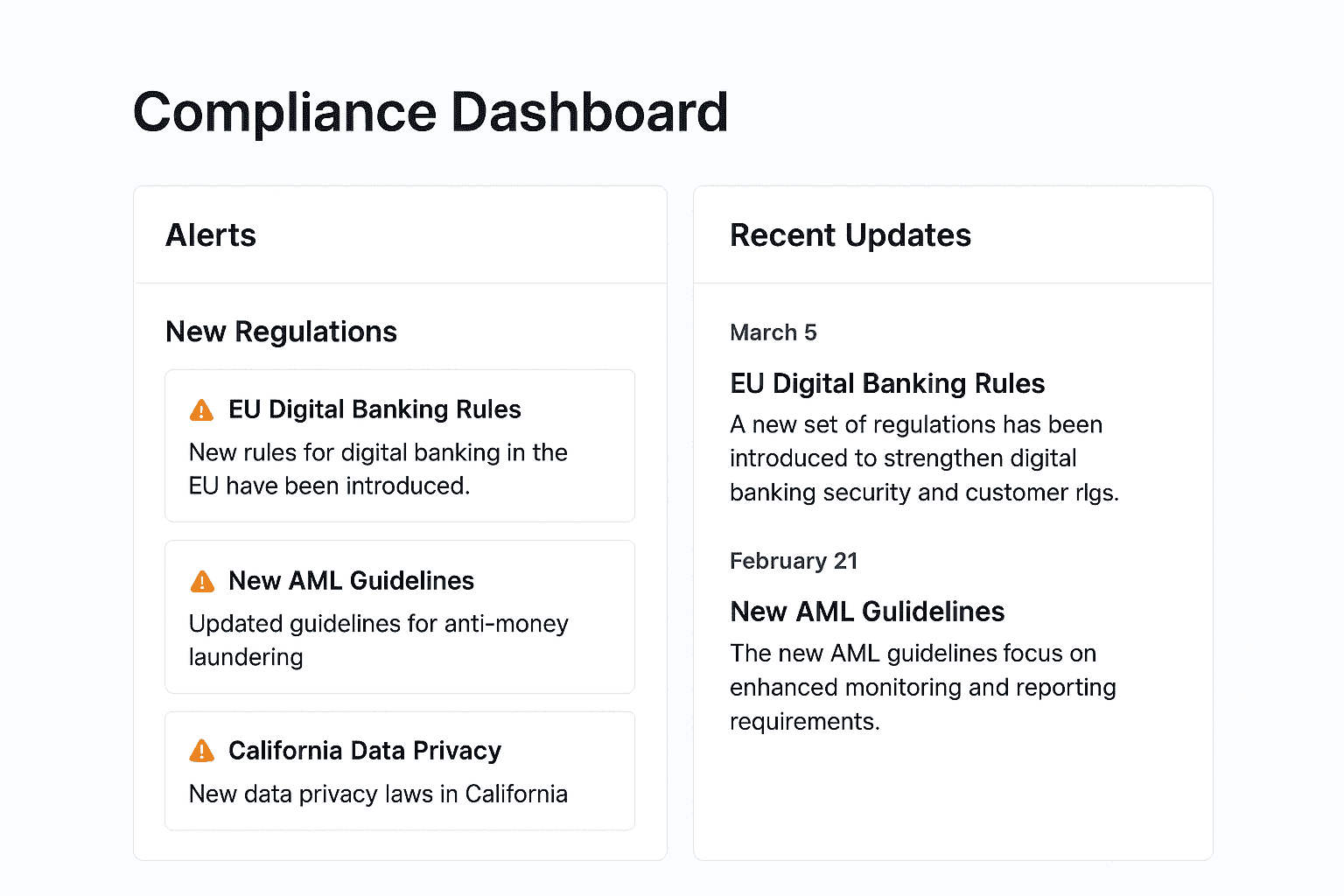
A well-known example of AI adoption in compliance comes from JPMorgan Chase, one of the largest banks in the world. The bank implemented an AI system to streamline contract and regulatory document review, which had previously taken thousands of hours of manual effort.
The AI tool could scan through regulatory updates and legal documents at scale, automatically extracting key clauses and identifying potential compliance risks. This allowed the compliance team to act quickly on relevant policy changes rather than spending weeks searching through lengthy documents.
According to reports, this shift saved the bank 360,000 hours of annual labor and significantly reduced the risk of overlooking critical updates. It also improved their ability to respond to regulators with accurate, well-documented records.
Use Case 3: E-Commerce
In the fast-paced world of e-commerce, customers expect instant answers. One of the most common questions they ask is: “Is this item in stock?” Yet, many customer support teams struggle to provide accurate answers because inventory data is often scattered across different platforms. For example, the product catalog may be hosted on Shopify or Magento, while stock availability is tracked in a separate warehouse management system. Traditional search tools and manual lookups force support agents to switch between dashboards, export spreadsheets, or wait for warehouse confirmations. This creates frustrating delays for customers and increases the chances of abandoned carts.
The AI Solution
This is where AI driven enterprise search comes into play. By connecting APIs from e-commerce platforms like Shopify with warehouse systems, an AI powered enterprise search system can unify all inventory data into a single, intelligent interface. Instead of digging through multiple tools, agents (or even AI-powered chatbots) can simply ask natural language queries like, “Is the red jacket in size M available right now?” The AI instantly retrieves the answer by scanning real-time stock data across all integrated systems.
GPTBots make this even more powerful. With its knowledge base capabilities, GPTBots can be trained on both structured product catalogs and unstructured support documentation. This allows it not only to confirm stock availability but also to provide related insights—like estimated restock dates, alternative product suggestions, or warehouse-specific delivery timelines. By combining semantic understanding with real-time API integrations, GPTBots ensures support teams always provide accurate and timely responses.
The Benefits
The benefits of this AI-powered setup are substantial:
- Faster response times: Customers receive real-time answers about stock without long delays.
- Reduced cart abandonment: Shoppers are less likely to leave when they have immediate confidence about availability.
- More efficient support teams: Agents save hours of manual lookups and repetitive queries.
- Personalized experience: The system can also suggest similar items in case a product is unavailable, improving upsell opportunities.
- Higher trust and loyalty: Customers appreciate transparency and reliability in order-related queries.
Real-World Example: Amazon’s AI-Enhanced Inventory System
One of the most recognized real-world examples comes from Amazon, which has long relied on AI to manage its complex inventory and customer interactions. Amazon integrates AI across its fulfillment centers and e-commerce platform to ensure that customers always see accurate product availability in real time.
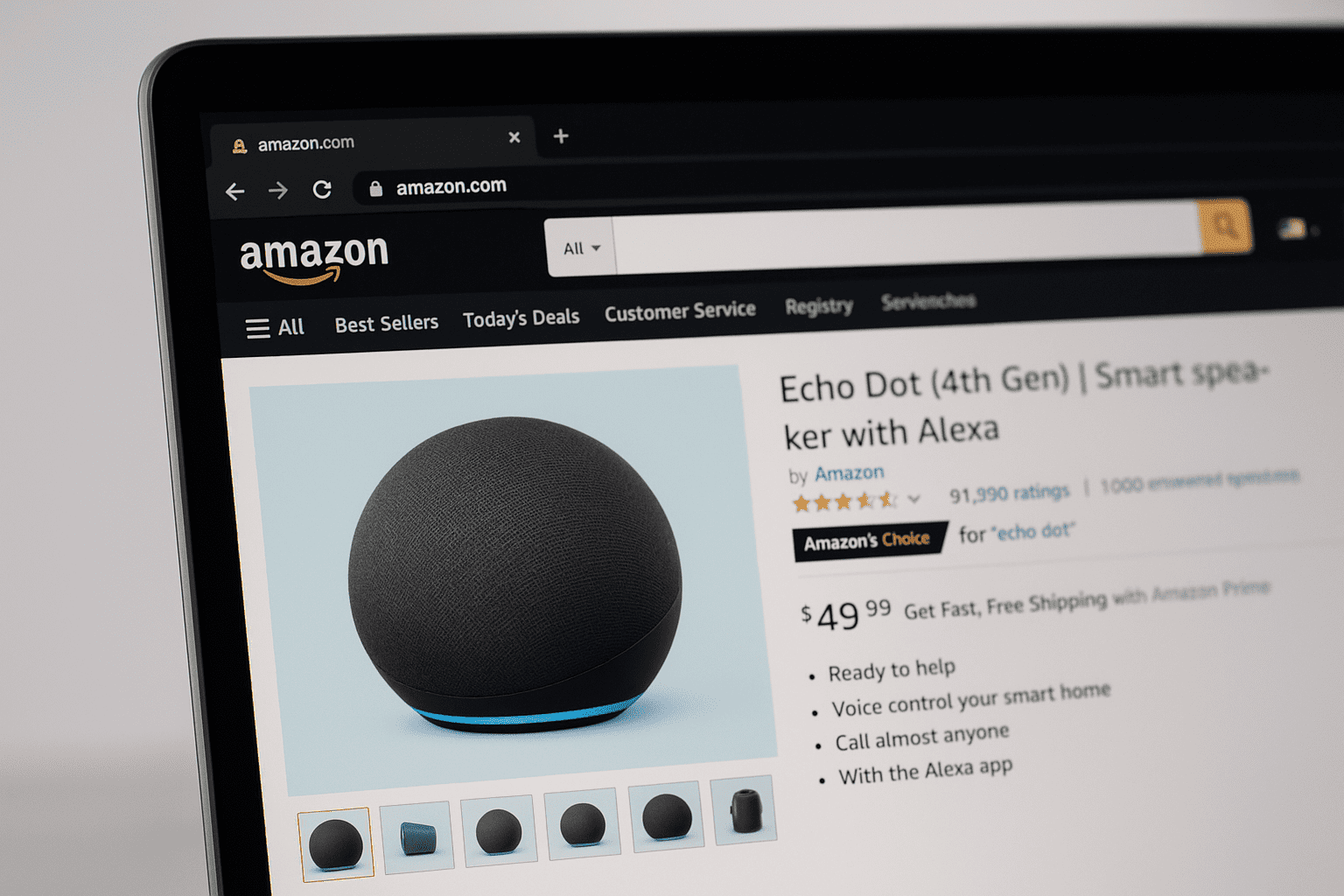
Instead of requiring customer support agents to check multiple systems, Amazon’s AI systems continuously synchronize data from warehouses, suppliers, and product listings. When a customer asks, “Is this in stock?”, the platform can instantly confirm availability, provide estimated delivery dates, and even suggest alternative sellers if one warehouse is out of stock.
The results have been transformative:
- Reduced response time for customer queries by automating real-time stock checks.
- Increased customer satisfaction through accurate and transparent availability updates.
- Optimized logistics, as AI not only reports availability but also recommends the fastest warehouse for delivery.
This shows how large-scale retailers are already leveraging AI driven enterprise search to unify fragmented data sources and give customers confidence in their shopping journey. While not every business has Amazon’s scale, tools like GPTBots now make it possible for mid-sized and growing e-commerce brands to apply the same principles; connecting Shopify, warehouse APIs, and customer support systems into a single intelligent knowledge base.
Use Case 4: Manufacturing
Manufacturing companies rely heavily on detailed technical documents—CAD files, engineering drawings, equipment manuals, and maintenance records. However, these resources are often stored across multiple systems and formats, making it extremely time-consuming for engineers to locate the exact information they need.
Something as specific as a torque setting for a bolt on a machine can take hours to find, delaying maintenance and increasing downtime. Traditional keyword-based searches are ineffective because engineers need precise technical answers, not a list of loosely related documents. The result is wasted time, higher operational costs, and even risks to safety when incorrect information is used.
The AI Solution: Intelligent Indexing and Retrieval
This is where AI-driven enterprise search transforms the process. By indexing both structured and unstructured data; CAD files, technical manuals, PDFs, schematics, and service reports—AI creates a unified and searchable knowledge hub. Using technologies such as Natural Language Processing (NLP), semantic search, and advanced document parsing, engineers can simply ask a natural language or even voice query like:
“What is the torque setting for the main valve on the Model X compressor?”
Instead of manually scanning documents, the AI powered enterprise search engine instantly retrieves the exact specification, highlights the relevant section in the original manual, and provides supporting context to ensure accuracy. This reduces guesswork and speeds up both production and maintenance tasks.
Benefits for Manufacturing Companies
- Reduced Downtime: Engineers can access precise technical specs in seconds, minimizing costly production delays.
- Improved Accuracy: Eliminates the risk of errors from outdated or misread documents by delivering authoritative answers.
- Higher Productivity: Engineers spend less time searching and more time applying knowledge to solve real problems.
- Knowledge Retention: Captures institutional knowledge by integrating manuals, CAD data, and technician notes into a centralized, intelligent system.
- Voice-Enabled Search: Enables hands-free queries for workers in environments where using keyboards isn’t practical, such as shop floors or assembly lines.
Role of GPTBots in Manufacturing
GPTBots extends these benefits with its knowledge base feature, which allows manufacturers to build a structured and exclusive repository of technical data. Complex CAD files, PDFs, and engineering reports can be parsed and stored, while advanced re-ranking and semantic recall ensure engineers always get the most precise answer. For example, GPTBots can show the exact torque setting while also linking back to the original page in the manual for validation—boosting both confidence and compliance.
With voice-query capabilities, GPTBots can support technicians directly on the floor, ensuring instant and accurate answers even during active maintenance. This reduces interruptions and significantly enhances operational efficiency.
Real-World Example: Siemens Smart Maintenance
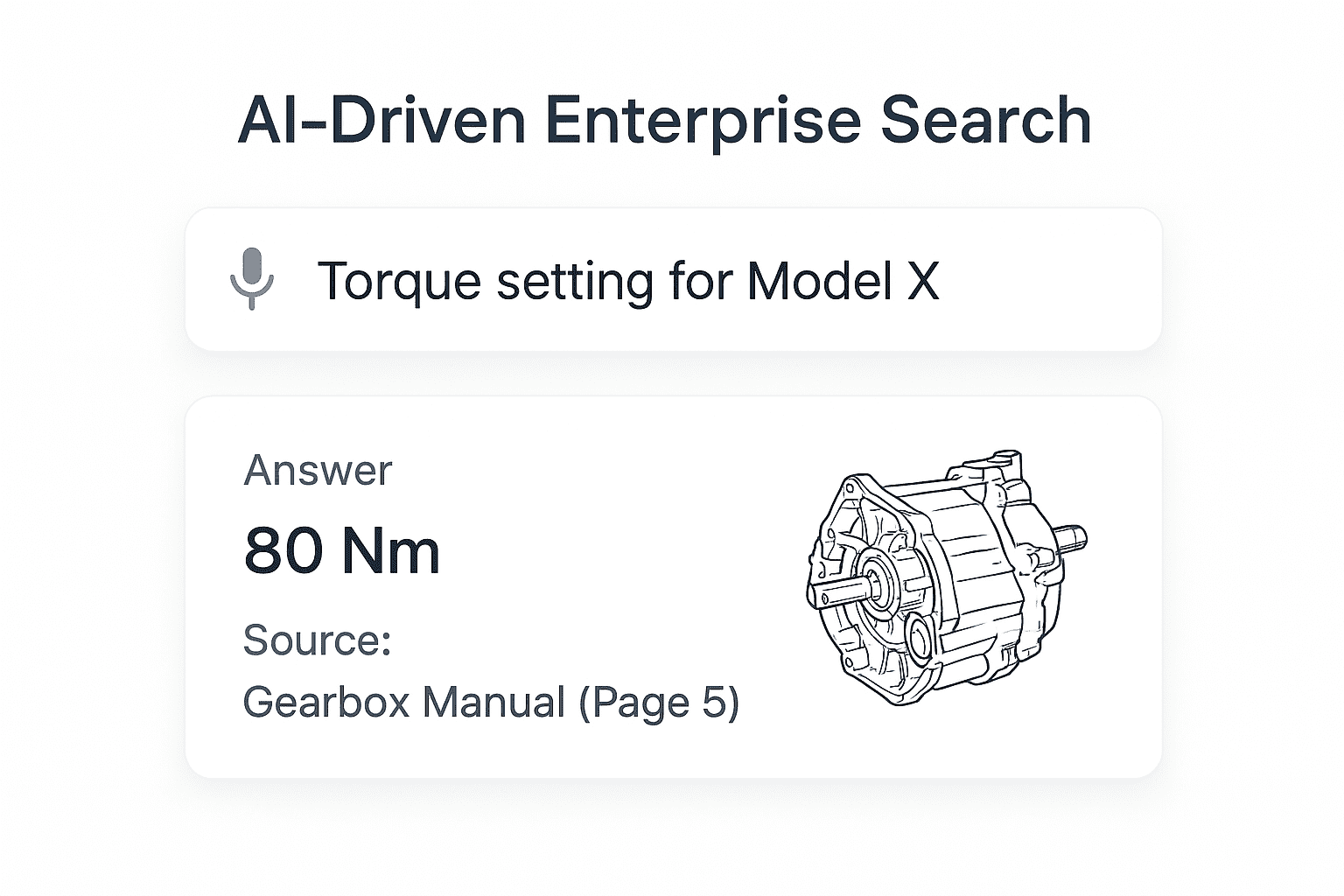
A practical example comes from Siemens, which has integrated AI into its smart manufacturing solutions. Their AI systems index equipment manuals, CAD files, and maintenance logs across production facilities worldwide. Engineers can query torque settings, maintenance intervals, or part compatibility through natural language search. In some cases, voice assistants are deployed directly on the factory floor.
The results have been significant: maintenance times were reduced by over 40%, errors from misinterpretation of manuals dropped sharply, and overall equipment efficiency (OEE) improved. This demonstrates how enterprise AI search is not just about convenience; it directly impacts manufacturing performance, safety, and profitability.
Use Case 5: Legal
In the legal industry, discovery is one of the most resource-intensive processes. Paralegals and junior associates often spend weeks combing through thousands of pages of contracts, case files, and legal documents to identify relevant clauses or precedents. Traditional keyword-based search is insufficient because it cannot understand legal nuance; words may appear in documents but carry entirely different meanings depending on context. This leads to missed references, duplication of effort, and inflated legal costs. Most importantly, long discovery cycles delay cases and affect client satisfaction.
The AI Solution: Context-Aware Legal Search
AI driven enterprise search offers a smarter approach by combining Natural Language Processing (NLP), semantic analysis, and machine learning to interpret legal language in context. Instead of simply matching keywords, the system can:
- Tag clauses across thousands of contracts, recognizing subtle differences in wording.
- Identify legal precedents by comparing current cases with historical ones.
- Surface relevant documents in seconds, even if they don’t contain exact keyword matches.
For example, a paralegal can type: “Find all contracts with non-compete clauses related to tech employees in California”. An AI powered enterprise search engine doesn’t just return documents with the words “non-compete,” it retrieves the exact contracts, highlights relevant passages, and may even suggest related cases where similar clauses were disputed.
Benefits for Legal Firms
- Faster Discovery: Reduces weeks of manual searching to minutes, freeing up time for higher-value legal analysis.
- Greater Accuracy: Minimizes missed clauses or overlooked precedents through intelligent tagging and contextual understanding.
- Cost Savings: Cuts down billable hours spent on repetitive tasks, lowering overall case preparation costs for clients.
- Stronger Legal Strategy: Surfaces related cases and clauses quickly, allowing lawyers to build more compelling arguments.
- Improved Compliance: Helps firms and corporate legal departments stay aligned with regulatory changes by indexing and monitoring legal updates.
Role of GPTBots in Legal Discovery
GPTBots makes this process even more powerful with its knowledge base feature tailored for complex documents. Legal firms can upload structured and unstructured files; contracts, agreements, case law databases, and even scanned PDFs. GPTBots’ advanced parsing maintains the document structure, ensuring clauses remain intact and easy to reference.
The platform also supports multi-channel recall and re-ranking, which ensures that the most relevant legal information appears first, significantly reducing noise. For example, when searching across thousands of employment contracts, GPTBots can instantly extract every non-disclosure clause, while also linking back to the exact page of the original contract. This not only speeds up discovery but also boosts confidence in the accuracy of results.
Real-World Example: Baker McKenzie’s AI-Enhanced Research

A well-known example comes from Baker McKenzie, one of the largest international law firms. The firm adopted AI-powered legal research tools to handle discovery across multinational cases. By indexing contracts and litigation documents across multiple jurisdictions, their legal teams were able to cut discovery timelines by more than 60%.
In one case, instead of assigning dozens of paralegals to manually review contracts, the AI system automatically flagged relevant clauses, grouped similar precedents, and highlighted potential risks. This not only saved the firm significant costs but also provided their clients with faster, more precise legal insights; strengthening client trust and competitive advantage.
6 Best AI Tools for Enterprise Search
1. GPTBots
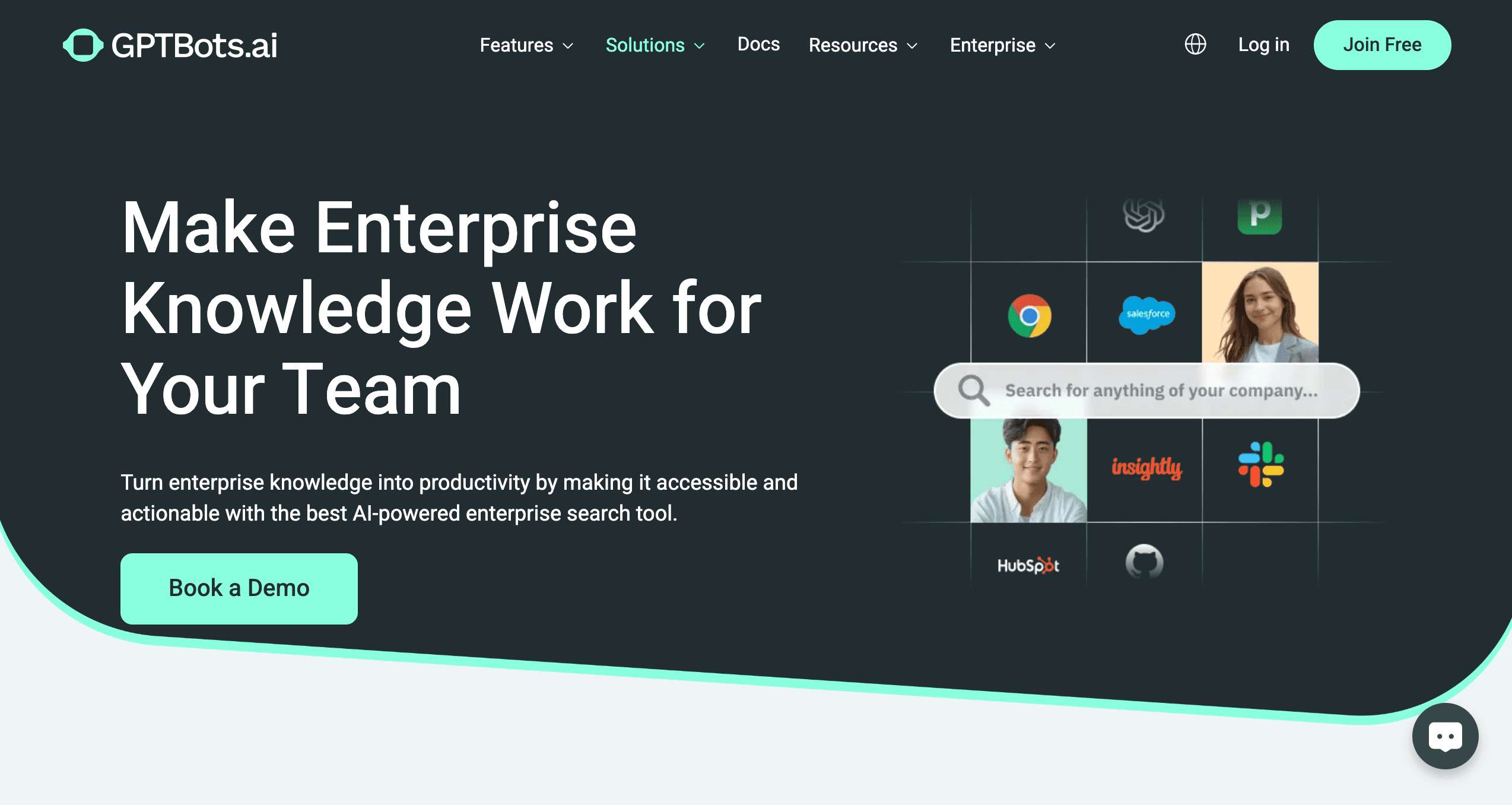
When businesses start looking for the best AI tools for enterprise search, one name that consistently comes out on top is GPTBots. Unlike traditional search systems, GPTBots is not just a search bar; it is a full AI driven enterprise search platform that allows companies to unify, structure, and intelligently retrieve data from multiple sources. Whether information is stored in PDFs, databases, spreadsheets, wikis, or third-party applications, GPTBots indexes it all and makes it instantly accessible with context-aware answers.
The standout strength of GPTBots is its Knowledge Base feature. Instead of treating data as scattered files or documents, GPTBots allows organizations to build an exclusive and structured knowledge hub. This hub supports both structured (tables, databases, spreadsheets) and unstructured (manuals, contracts, reports, CAD files, images) data, ensuring that no piece of information is left behind. Once uploaded, the data is intelligently parsed and organized so users can retrieve specific details using natural language queries, or even voice search in supported workflows.
For example, a healthcare provider could upload patient protocols, medical guidelines, and treatment records into GPTBots, then instantly ask, “What’s the recommended dosage for X condition based on our protocols?” Within seconds, GPTBots delivers not only the direct answer but also cites the original source for validation. This approach doesn’t just improve search; it improves trust, compliance, and decision-making.
Another important factor is security and compliance. GPTBots is SOC 2 compliant, ensuring that sensitive enterprise data, whether financial, legal, or patient-related, is handled under strict privacy and security standards. This makes it a trustworthy choice for industries where data security is non-negotiable. Additionally, it comes with API and database connectors, allowing companies to integrate GPTBots with their existing systems (like CRMs, ERPs, or cloud storage). This means employees don’t have to jump between different apps; GPTBots brings everything together in one unified platform.

Key Features of GPTBots
- Robust Knowledge Base: Builds a centralized, exclusive hub for both structured and unstructured enterprise data.
- API & Database Connectors: Seamlessly integrates with third-party platforms, ensuring data flows smoothly across systems.
- Advanced Parsing: Converts and preserves document structures from PDFs, CAD files, spreadsheets, and more for precise retrieval.
- Contextual Accuracy: Uses semantic search, re-ranking, and NLP to deliver highly relevant and verified answers.
- Real-Time Updates: Synchronizes data across multiple channels with live updates for accurate information access.
- Security & Compliance: SOC 2 certified with enterprise-grade encryption and data isolation for maximum protection.
- Multi-Channel Support: Works across web, APIs, and integrated business tools to deliver knowledge where employees need it.
Pros
- Extremely powerful AI powered enterprise search with contextual understanding.
- Easy integration with existing systems through API and database connectors.
- SOC 2 compliance ensures enterprise-grade data security.
- Supports both structured and unstructured knowledge sources.
- Instant, accurate, and citation-backed answers that build trust.
- Scales well across industries such as healthcare, finance, legal, e-commerce, and manufacturing.
- User-friendly interface with advanced document parsing capabilities.
Cons
- Not really any significant disadvantages and this is exactly why GPTBots ranks at the top of our list of the best AI tools for enterprise search.
2. Elasticsearch
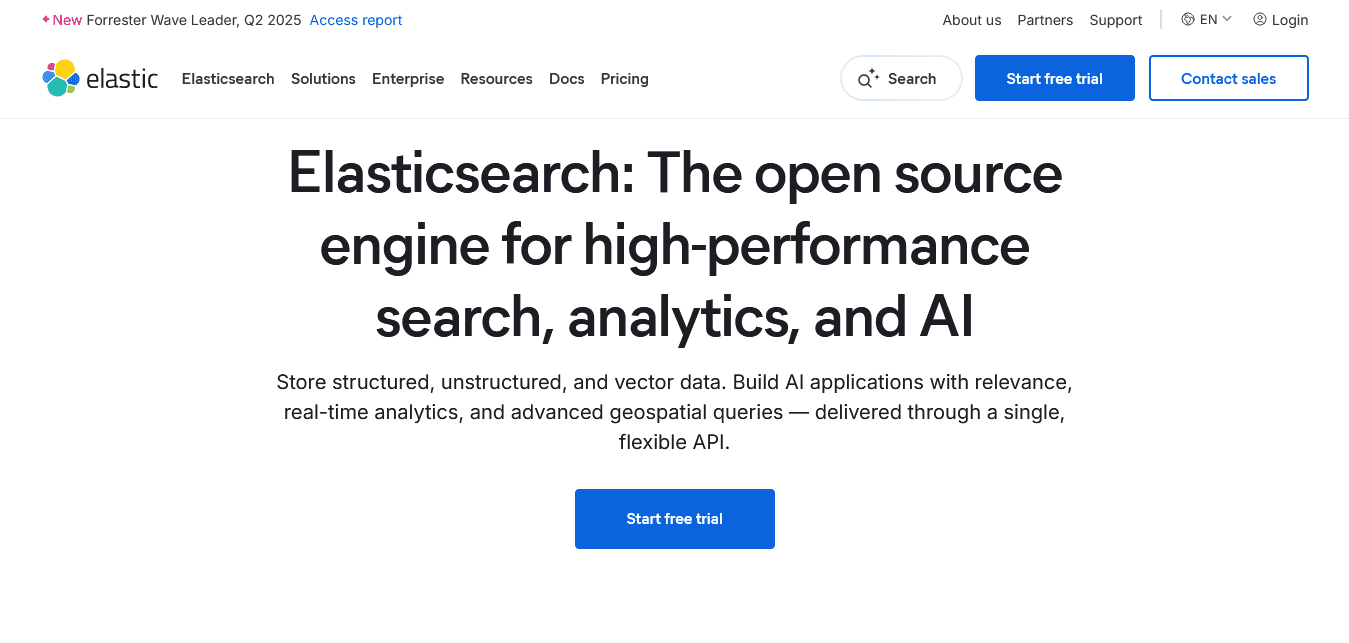
Elasticsearch is one of the most well-known platforms in the field of AI-driven enterprise search. It is an open-source, distributed search and analytics engine that powers some of the world’s largest applications. Unlike traditional databases, Elasticsearch uses a document-oriented model, where data is stored and retrieved in JSON format. This approach makes it flexible, fast, and highly scalable for handling unstructured data.
Organizations often use Elasticsearch as part of the Elastic Stack (commonly known as ELK Stack, which includes Elasticsearch, Logstash, and Kibana). This ecosystem enables businesses to collect data from multiple sources, process it in real time, and visualize it through interactive dashboards. For enterprise search, Elasticsearch ensures instant access to relevant information while maintaining accuracy and context.
Pros
- Extremely fast search responses.
- Handles massive data volumes efficiently.
- Provides accurate and relevant results.
- Rich ecosystem with Kibana and Logstash.
Cons
- Initial setup and configuration can be complex, especially for non-technical users.
3. Google Cloud Search
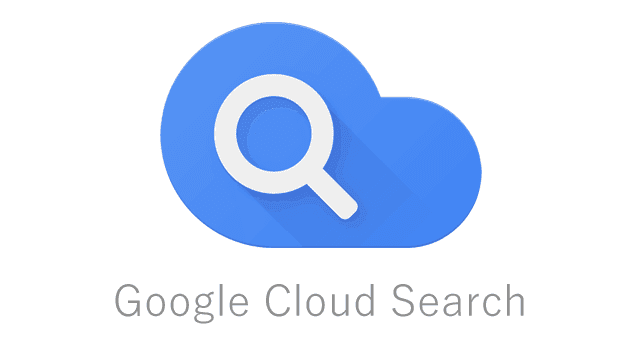
Google Cloud Search is Google’s enterprise-grade solution designed to help organizations find information across multiple business platforms. As part of Google Workspace, it integrates seamlessly with Gmail, Drive, Docs, Calendar, and other Google tools. For businesses that rely heavily on the Google ecosystem, this tool offers a unified search experience that is both intuitive and powerful.
One of the biggest advantages of Google Cloud Search as an AI-driven enterprise search tool is its ability to adapt to organizational security models. Search results are personalized and restricted based on user permissions, ensuring that employees only see the data they are authorized to access. This feature makes it especially valuable for enterprises with strict compliance requirements.
Pros
- Centralized search across all Google Workspace apps.
- Simple, user-friendly design.
- Expands beyond Google tools with external connectors.
- Secure and compliance-ready.
Cons
- Requires a separate app instead of being built directly into Gmail or Drive.
- At times, search speed can be slower than expected.
4. Azure AI Search

Azure AI Search, previously known as Azure Cognitive Search, is Microsoft’s enterprise solution for intelligent information retrieval. It is designed for organizations that deal with massive amounts of unstructured and structured data. As one of the best AI tools for enterprise search, it provides AI-powered enrichment that transforms raw data into searchable content, making it extremely valuable for industries like healthcare, retail, and finance.
The platform also uses AI techniques like Optical Character Recognition (OCR) and natural language processing to extract insights from documents, images, and even scanned PDFs. By converting unstructured data into structured JSON outputs, Azure AI Search makes complex information searchable and accessible. For enterprises, this means reduced manual effort, faster data discovery, and improved decision-making.
Pros
- Highly customizable for advanced search scenarios.
- Strong integrations with Microsoft ecosystem.
- Intuitive setup process.
- Ideal for large-scale enterprise use cases.
Cons
- Pricing can be high compared to other solutions, especially for data-heavy industries.
5. Sinequa
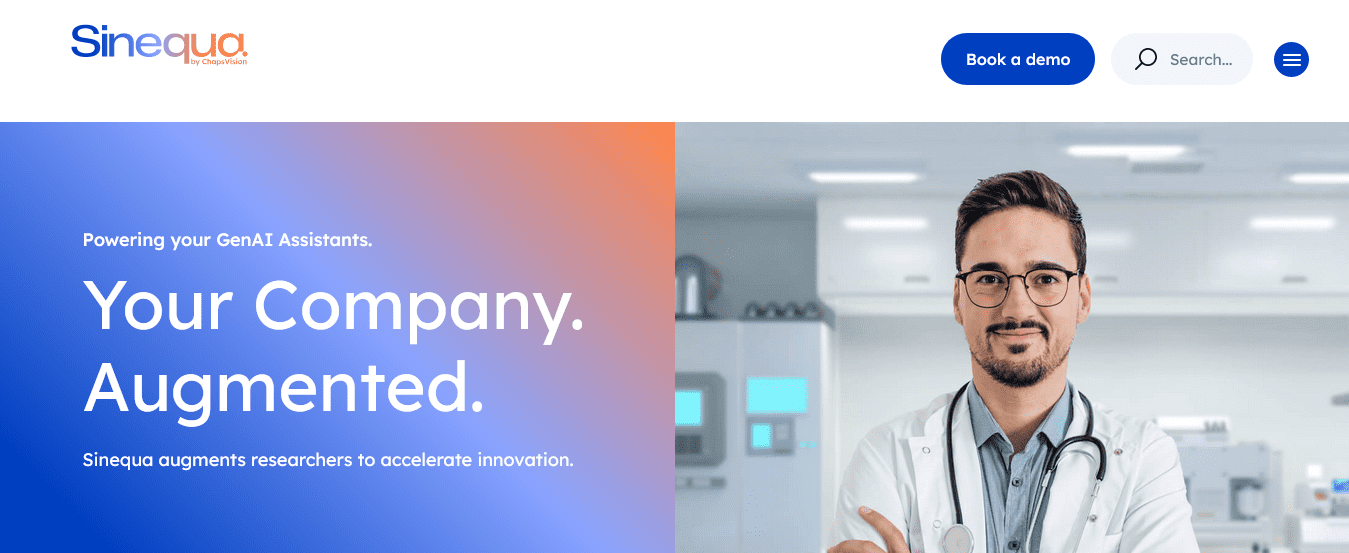
Sinequa is a powerful AI-driven enterprise search platform designed for large organizations dealing with massive volumes of complex data. What sets it apart is its ability to unify information from both structured and unstructured sources, such as databases, internal systems, cloud applications, research archives, and even legacy tools. This makes Sinequa an ideal solution for enterprises that operate in highly regulated industries like finance, government, and pharmaceuticals, where data must be accessible yet secure.
The platform uses advanced natural language processing (NLP) and machine learning models to understand user intent and deliver highly relevant results. Over time, Sinequa continuously learns from user behavior and tailors search outcomes based on preferences, roles, and past activity. This personalization ensures employees spend less time searching for information and more time applying insights to their work.
Pros
- Exceptional at handling unstructured and structured data together.
- Strong focus on compliance and security.
- Learns from user interactions to deliver more accurate results.
- Highly scalable for enterprise-wide deployment.
Cons
- Steep learning curve for new users due to its depth and complexity.
6. GoLinks
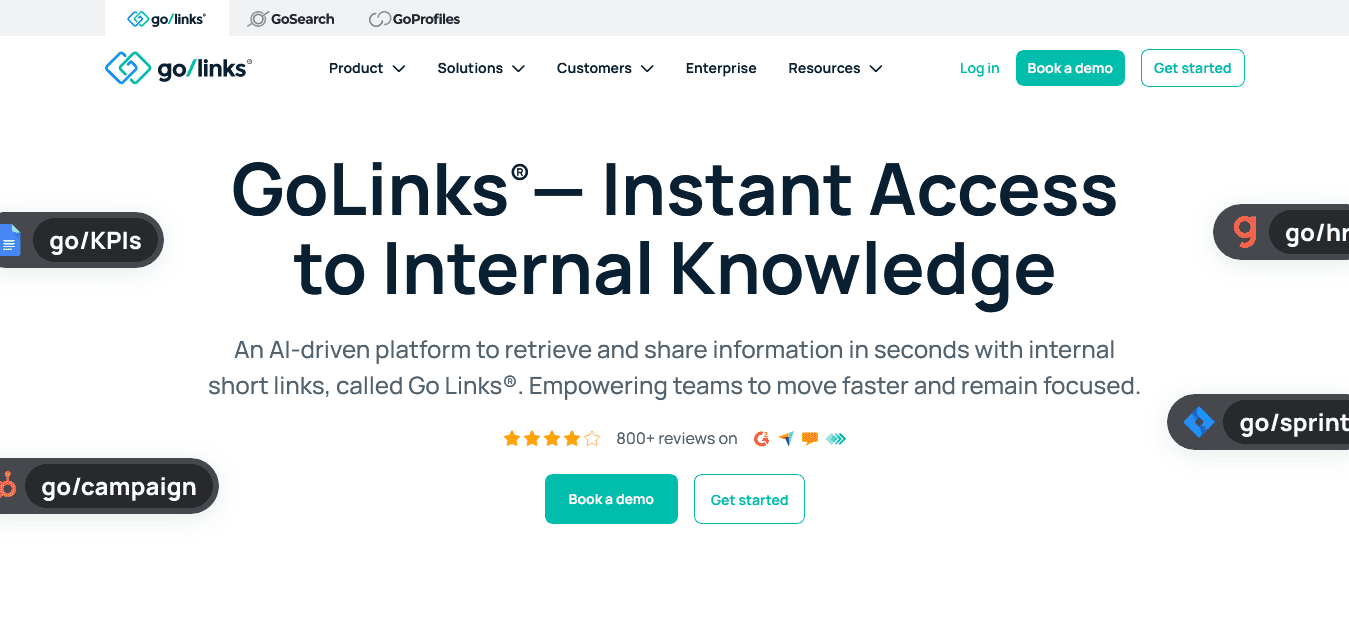
GoLinks takes a different approach to enterprise search compared to other platforms on this list. Instead of focusing on traditional data indexing and NLP, GoLinks simplifies knowledge sharing by turning long, complex URLs into short, memorable “go links” (for example, typing go/marketing instead of remembering a lengthy internal link). While lightweight in design, this platform solves a big challenge for teams: quick access to frequently used resources.
For teams working in hybrid or remote environments, GoLinks becomes especially useful. Employees no longer waste time searching through drives, chat messages, or old emails to find links. Instead, they can instantly access information by typing a simple keyword in the browser. This makes it a practical tool for knowledge management and internal navigation, even if it isn’t a full-scale AI-driven enterprise search platform like Sinequa or Elasticsearch.
Pros
- Extremely easy to use and adopt across teams.
- Saves time by eliminating the need to search for frequently used links.
- Supports integrations with popular workplace tools.
- Provides useful analytics on resource usage.
Cons
- Limited customization compared to larger enterprise search platforms.
- Requires memorization of keywords for each link.
- Link management can get messy if too many redirects are created.
Final Thoughts
In today’s data-heavy business environment, information is often scattered across countless platforms, databases, and communication tools. Traditional search solutions struggle to keep pace with the complexity and scale of modern enterprises. This is where AI-driven enterprise search makes the real difference. By combining semantic understanding, natural language processing, and intelligent connectors, it unifies knowledge bases and delivers instant, context-aware answers that employees can trust.
While there are several strong contenders in this space, GPTBots is considered as the most complete solution. With its ability to connect directly to APIs, databases, and cloud applications, along with SOC2-level compliance, GPTBots ensures secure, accurate, and real-time knowledge access.
If you’re ready to see the impact of AI-driven enterprise search in action, start by exploring GPTBots’ free search demo and experience how quickly it transforms knowledge discovery. For organizations that want to take the next step, you can also download the Enterprise Search Implementation Checklist to guide your rollout with confidence. Together, these resources will help your business move from fragmented data to seamless intelligence.
Ready to get started?
Get a Custom Demo





